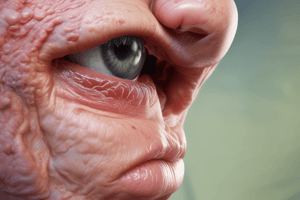Podcast
Questions and Answers
What does the term 'Cyte/Cyt' refer to?
What does the term 'Cyte/Cyt' refer to?
- Cell (correct)
- Nail
- Skin
- Hair
What is the meaning of 'derm/o'?
What is the meaning of 'derm/o'?
skin
Define 'onych/o'.
Define 'onych/o'.
nail
What is 'pil/o' associated with?
What is 'pil/o' associated with?
What does 'seb/o' mean?
What does 'seb/o' mean?
What is the definition of 'sudor/i'?
What is the definition of 'sudor/i'?
What color does 'albin/o' represent?
What color does 'albin/o' represent?
What does 'Cyan/o' stand for?
What does 'Cyan/o' stand for?
What is the meaning of the prefix 'Epi'?
What is the meaning of the prefix 'Epi'?
Define 'erythr/o'.
Define 'erythr/o'.
What does 'ichthy/o' mean?
What does 'ichthy/o' mean?
What does the suffix '-algia' signify?
What does the suffix '-algia' signify?
What does 'my/o' refer to?
What does 'my/o' refer to?
What is the meaning of 'neur/o'?
What is the meaning of 'neur/o'?
Define '-itis'.
Define '-itis'.
What does 'angi/o' mean?
What does 'angi/o' mean?
What is the meaning of the prefix 'pedi/o'?
What is the meaning of the prefix 'pedi/o'?
What does 'myel/o' refer to in the context of the nervous system?
What does 'myel/o' refer to in the context of the nervous system?
Define 'psych/o'.
Define 'psych/o'.
Flashcards are hidden until you start studying
Study Notes
Medical Root Words and Their Meanings
- Cyte/Cyt: Refers to cells, the basic building blocks of all living organisms.
- Derm/o: Pertains to the skin, the largest organ in the human body.
- Onych/o: Relates to nails, which protect the tips of fingers and toes.
- Pil/o: Indicates hair, an integral part of the body's integumentary system.
- Seb/o: Refers to sebum or oil produced by sebaceous glands in the skin.
- Sudor/i: Pertains to sweat, a key component in thermoregulation.
- Albin/o: Relates to white, often used in medical terms relating to pigmentation.
- Cirrh, Jaund, Xanth: Refers to yellow; jaundice is a condition causing yellowing of skin and eyes.
- Cyan/o: Relates to blue, often indicating a lack of oxygen in tissues.
- Epi: Means upon or over, commonly used in anatomical terms.
- Erythr/o: Refers to red, often associated with blood or red blood cells.
- Fero: Means to carry, indicating transport within biological contexts.
- Ichthy/o: Relates to dry or scaly skin conditions.
- Kerat/o: Refers to hornlike, often in relation to the outer layer of skin or associated structures.
- Melan/o: Pertains to black, commonly relating to melanin pigmentation.
- Myc/o: Relates to fungus, important in discussions about fungal infections.
- Scler/o: Refers to hardening, often in relation to tissues or organs.
- Sub: Means below, commonly used in anatomical descriptions.
- Xer/o: Indicates dryness, often in relation to skin or mucous membranes.
- -algia: Refers to pain, generally used to denote various types of pain.
- Amphi: Means both sides, often used in anatomical terms.
- Ankyl/o: Indicates stiffness or fusion of joints.
- Arthr/o: Refers to joints, key in discussions about movement and mobility.
- Brachi/o: Pertains to the arm, often used in descriptions of upper limb anatomy.
- Calcane/o: Refers to the calcaneus or heel bone, key in foot anatomy.
- Carp/o: Pertains to the wrist bones, important in hand movements.
- Cervic/o: Refers to the neck, a significant area for numerous vital structures.
- Cheir/o: Relates to the hand, critical for functional anatomy of the upper limb.
- Chondr/o: Pertains to cartilage, important in joint and skeletal structure.
- Cost/o: Refers to ribs, significant in protecting thoracic organs.
- Crani/o: Pertains to the cranium, the skull protecting the brain.
- Dactyl/o: Refers to fingers and toes, key in digit anatomy.
- -desis: Indicates stabilization or fusion, often of joints or bones.
- -ectomy: Refers to excision or removal, commonly used in surgical terminology.
- Electro/o: Pertains to electricity, often relevant in neurological contexts.
- Femur/o: Indicates the femur or thigh bone, the longest bone in the body.
- -gram: Refers to a written record, commonly seen in medical imaging.
- Humer/o: Pertains to the humerus, the bone of the upper arm.
- -itis: Indicates inflammation, a common response to injury or infection.
- Kinesi/o: Refers to movement, critical in understanding locomotion and function.
- Kyph/o: Indicates a hump or curvature, often associated with spinal conditions.
- -logy: Denotes the study of, commonly used in naming scientific disciplines.
- Lord/o: Refers to a forward curve, often discussing spinal curvature.
- Lumb/o: Pertains to the lower back, a crucial area for support and mobility.
- -malacia: Indicates softening, often in terms of tissues or organs.
- My/o: Refers to muscle, central to discussions of movement and strength.
- Myel/o: Pertains to bone marrow, significant in blood cell production.
- -oma: Refers to tumors, benign or malignant growths.
- Orth/o: Indicates correction or straightening, commonly related to bones and joints.
- Os/te/o: Refers to bone, fundamental element of the skeleton.
- Ped/o: Indicates child or foot, used in pediatric and podiatric contexts.
- Pelv/o: Pertains to the pelvis, significant in anatomy and reproductive health.
- Phalang/o: Refers to the bones of fingers and toes, integral in dexterity.
- -physis: Means to grow, often in terms of bone growth.
- -plasty: Refers to surgical repair, often of tissues or organs.
- -porosis: Indicates porosity, often used when discussing bone density.
- -scopy: Means visual examination, commonly used in diagnostic procedures.
- Spondyl/o, Vertebr/o: Refers to vertebrae, essential for spinal support and flexibility.
- Syn-: Means joined together, often refers to fusion in anatomy.
- Thorac/o: Pertains to the thorax or chest, an area housing vital organs.
- Zygo-: Means joined together, often used in anatomical contexts.
- Fasci/o: Refers to fibrous membranes, important in supporting muscles.
- Fibr/o: Indicates fiber, important in connective tissue discussions.
- Hemi: Means half, often used in terms like hemiplegia.
- Ligament/o: Refers to ligaments, key in joint stability.
- Muscul/o: Pertains to muscles, vital for movement and support.
- Para-: Means beside or beyond, often indicating relationships in anatomy.
- -paresis: Indicates partial paralysis, critical in neurology discussions.
- -plegia: Refers to paralysis, often used to describe conditions affecting movement.
- Quadri-: Refers to four, used in terms describing limb function.
- Sthen/o: Means strength, often in musculoskeletal discussions.
- Tend/o: Refers to tendons, connecting muscle to bone.
- Ton/o: Indicates tone, often in discussions pertaining to muscle tension.
- Arachnid/o: Refers to spiders, relevant in discussions of certain diseases.
- Cephal/o: Pertains to the head, integral in neurology and anatomy.
- Cerebell/o: Refers to the cerebellum, key in motor control.
- Cerebr/o: Pertains to the cerebrum, responsible for higher brain functions.
- Cortic/o: Indicates outer layer, often in references to organs like the adrenal glands.
- Encephal/o: Refers to the brain, central to the nervous system.
- Gangli/o, Ganglion/o: Pertains to ganglia, involved in nerve signal transmission.
- Gli/o: Refers to glue, specifically the supportive tissue in the nervous system.
- Hydro/o: Indicates water, often referenced in bodily fluids and hydration.
- Latro/o: Refers to physician or treatment, key in medical professions.
- -Mania: Indicates a morbid attraction to something, often used in psychological terms.
- Meningi/o: Refers to membranes, particularly those surrounding the brain and spinal cord.
- Ment/o: Pertains to the mind, significant in psychology and neuroscience.
- -mnesia: Refers to memory, often discussed in cognitive science.
- Myel/o (Nervous System): Refers specifically to the spinal cord, crucial for nervous system function.
- Neur/o: Pertains to nerves or nervous system, fundamental in neurology.
- -oid: Indicates similarity, often found in naming related structures or conditions.
- -phasia: Relates to speech, important in language and communication disorders.
- Phobia: Refers to unreasonable fear, significant in psychology.
- Psych/o: Pertains to the mind, central to mental health discussions.
- Schiz/o: Means to split, often used in discussions of mental health conditions.
- Spin/o: Refers to the spinal cord, critical in understanding neurological function.
- Angi/o: Pertains to vessels, essential in discussions about circulation.
- Aort/o: Refers to the aorta, the main artery supplying blood to the body.
- Arteri/o: Pertains to arteries, the vessels carrying blood away from the heart.
- Ather/o: Indicates fatty deposits, relevant in discussions of cardiovascular health.
- Atri/o: Relates to the atrium, one of the heart's chambers.
Studying That Suits You
Use AI to generate personalized quizzes and flashcards to suit your learning preferences.





